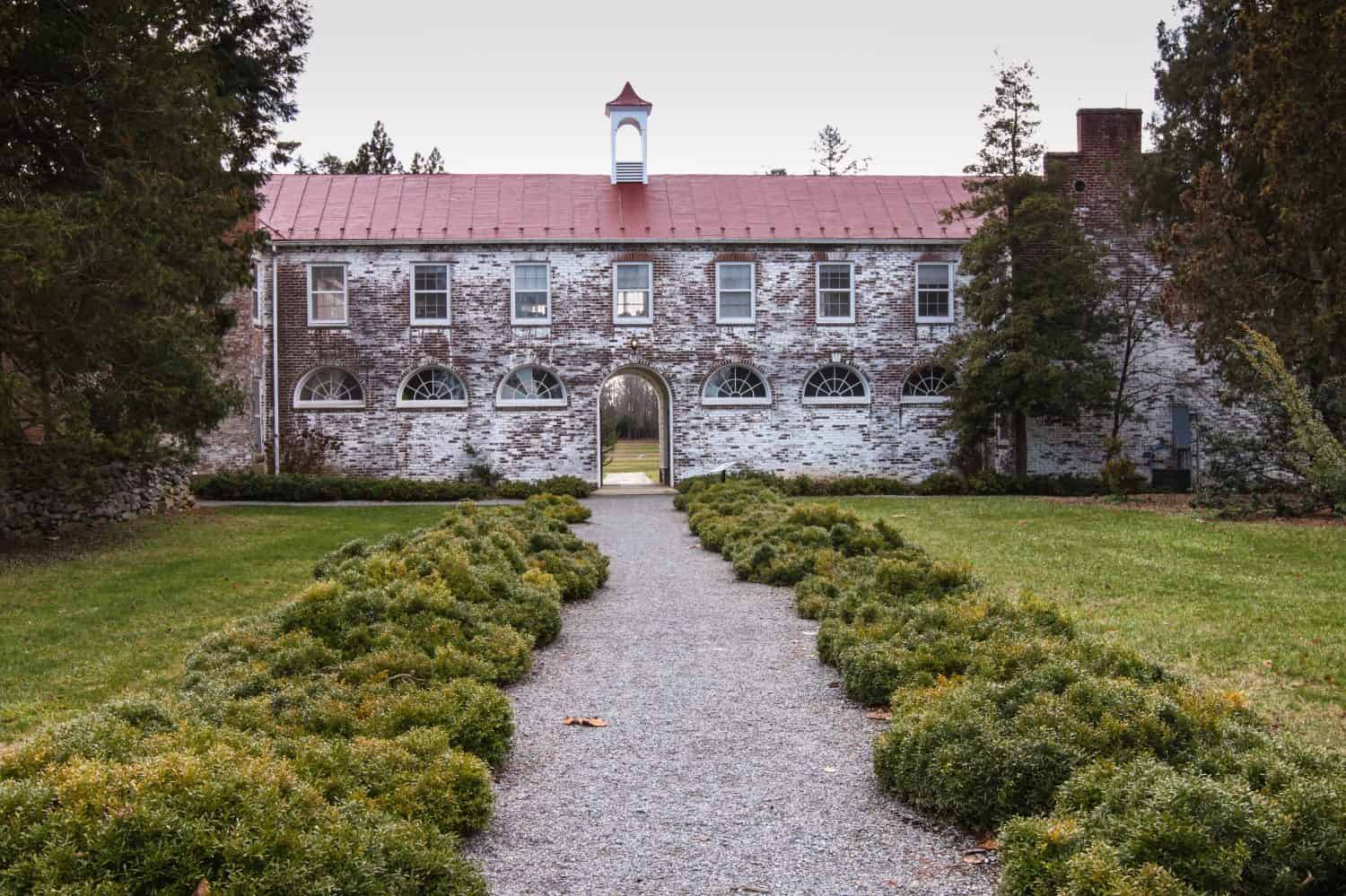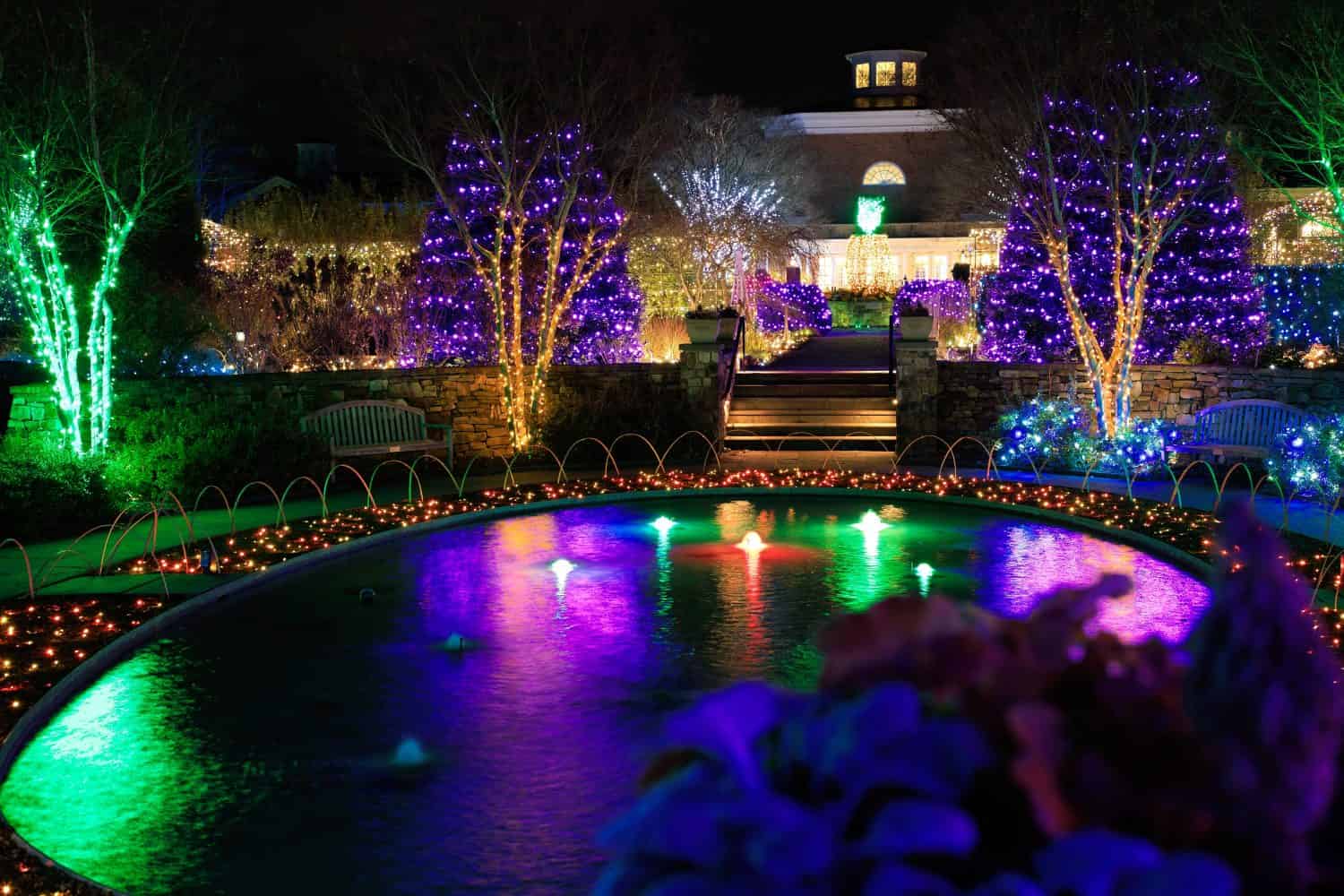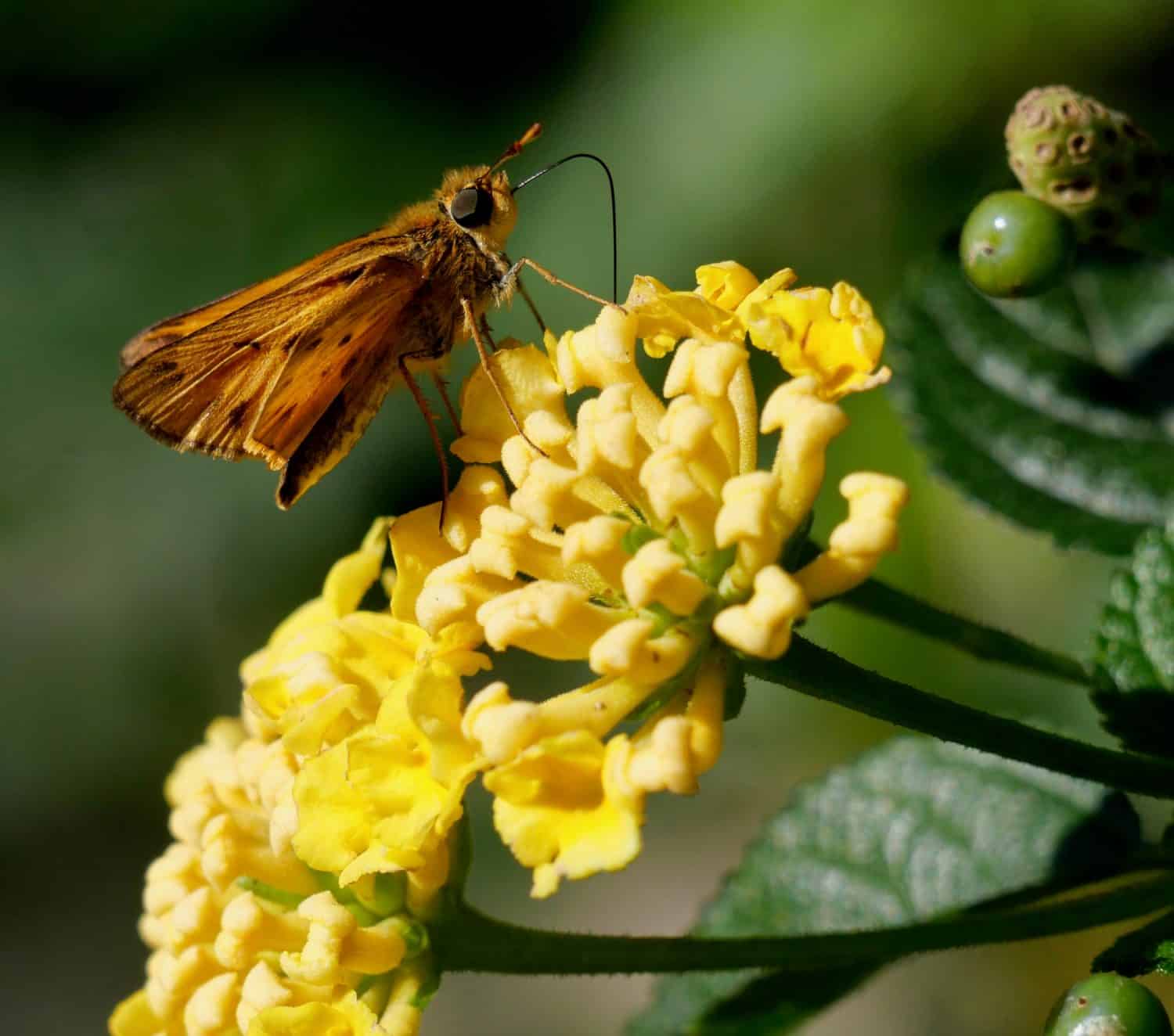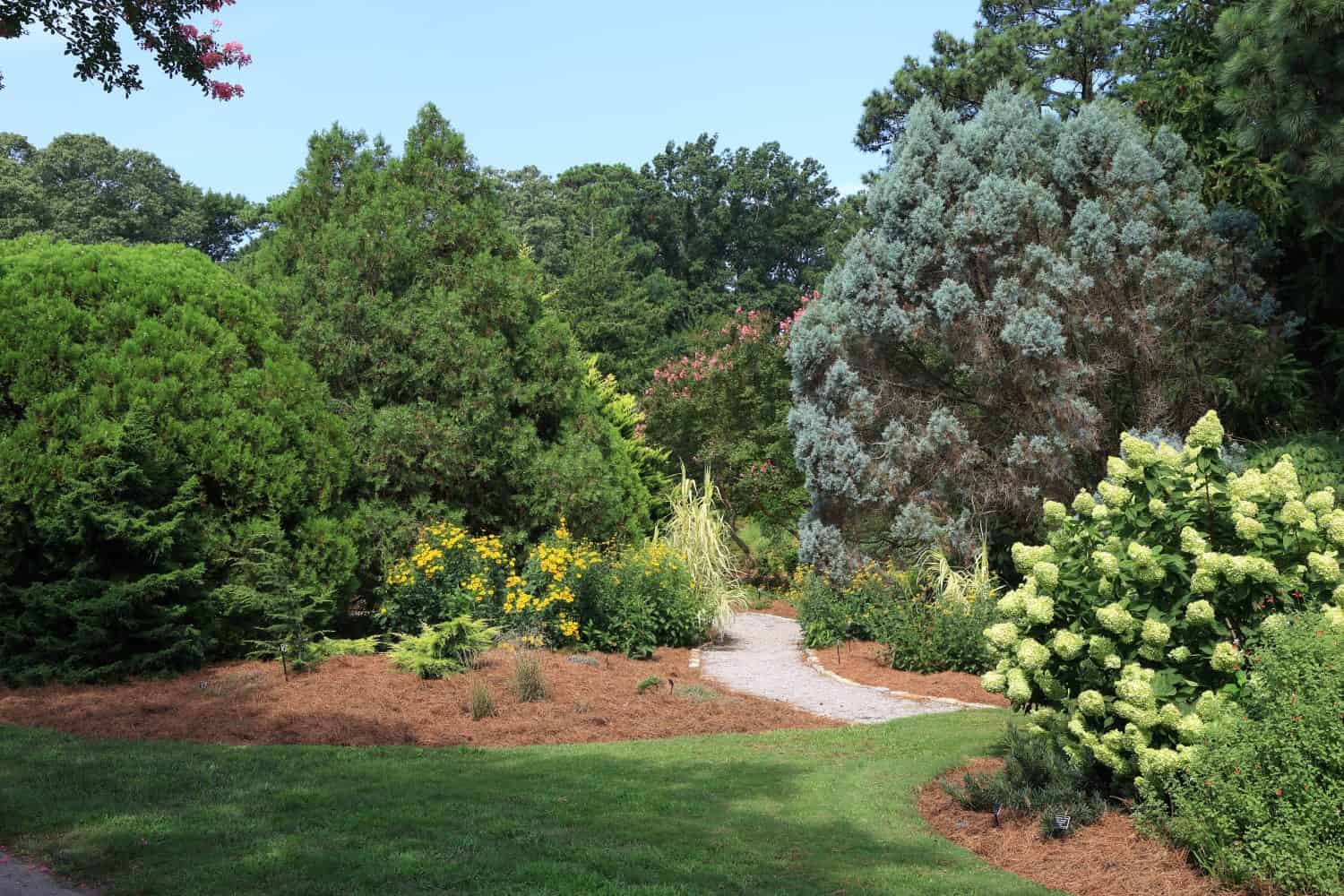Virginia is for lovers…of plants. There are plenty of botanical gardens to visit and learn about the amazing agriculture and native plants in this state. Many include ornamental gardens and other cultivated areas, as well as natural meadows. Some of the best have educational centers and interactive gardens to get the entire family involved. As such a strong part of early colonial American history, Virginia gardens often feature examples of what early settlers would have grown. Here are some of the best botanical gardens in Virginia to visit the next time you are in the Old Dominion.
1. Norfolk Botanical Gardens

The bridge is a particularly great place for photos at the Norfolk Botanical Garden.
©Anne Katherine Jones/Shutterstock.com
This 175-acre garden has been around since 1939 and has a long history of creative spectacular gardens as well as special events and exhibits. Some of Norfolk Botanical Garden’s most visited spots include the rose garden, the World of Wonders children’s garden with a splash pad, the canal path, and the Mirror Lake. The butterfly garden is a new addition in the past few years and a Garden of Tomorrow section is under construction. There is also an educational center that hosts special programming to teach about native plants and the local ecosystem. You can even purchase plants through the garden occasionally.
Special events are something extra special here. The garden and surrounding communities take great pride in things like the Garden of Lights holiday display, visits with Santa, plant shows hosted by local societies and groups, market days, paint nights, and storytime for kids.
Because it is large, there is a tram that provides transportation to some key locations in the garden. Parking is on one end, near the Norfolk Airport (a bonus for those who like to watch planes land and take off). The main parking lot is near the visitor’s center, where many of the special programs are held. The tram will pick you up at the visitor’s center and take you around the garden. You can also walk on one of the many paths. Because there is only one entrance to the garden, traffic can move slowly at times, especially during peak events like the winter light show. During the day and outside of special events, entry to the garden is easy and fast.
2. Virginia State Arboretum

The Virginia State Arboretum is known for its sense of history, including historic buildings and groves of trees.
©Cvandyke/Shutterstock.com
The Virginia State Arboretum, also called the Orland E. White Arboretum, is 172 acres and part of the larger Blandy Experimental Farm, operated by the University of Virginia. The state arboretum has many trees and other plants native to Virginia and focuses on local plant species. The collection of trees, including many boxwoods and pines, is particularly impressive. The boxwood garden hosts 162 different cultivars and is the backup for the National Arboretum. The Gingko grove has over 300 trees which turn a stunning shade of yellow in the fall. Smaller gardens include a herb garden, a pollinator garden, and a memorial iris collection. You can also plant a tree in honor or memory of a loved one through the memorial program.
The Historical Quarters building is at the center of the arboretum and makes a beautiful backdrop for photos. The gardens immediately around the Historical Quarters feature plants that are either native to Virginia or that have come from other locations but do well in the Virginia climate. Located in Boyce, Virginia, the arboretum and surrounding farm is west of Washington, D.C. in the Shenandoah mountains. As part of the Virginia countryside, this area is the perfect place not just for plants but specifically for Virginia native plants to grow and thrive.
The arboretum is free to visit and open 365 days per year. Special events hosted at the arboretum include a plein-air painting festival in the fall, Mother’s Day events in the spring, and holiday wreath-making workshops using natural materials from the grounds. Blandy Experimental Farm focuses on research and conservation, and hosts educational events like summer camps, seed swaps,
3. Lewis Ginter Botanical Gardens

Visit Lewis Ginter Botanical Gardens in the winter months to enjoy the spectacular light display.
©Dr Tom Photography/Shutterstock.com
This garden in Richmond, Virginia is set on 50 acres and includes more than 10 themed gardens, such as a children’s garden, rose garden, and healing garden. There are plenty of walking trails through the garden with guides as well as photo tours. You can download an app to learn more about the plants in the garden. The children’s garden is a particularly pleasant walk for the whole family. It takes you past Sydnore Lake, over the scenic Lotus Bridge, and by the farm garden and international village space.
One of the most beautiful places to visit at Lewis Ginter isn’t a garden at all. The conservatory has a 63-foot glass dome that is unlike any other in the entire state of Virginia. You can enjoy a delicious lunch or coffee at the cafe in the Visitor’s Center on your way into the garden. Other spaces throughout the garden include the carriage house, tea house, and historic Bloemendaal House.
Like other botanical gardens, Lewis Ginter hosts special events. The ButterfliesLIVE! event is perfect for families and celebrates local butterflies visiting the garden. There are special events in the children’s garden as well as self-paced adventures you can take on your own in the garden. The main display is open in the Conservatory.
4. Meadowlark Botanical Gardens

Summer is a great time to visit Meadowlark Botanical Gardens in Vienna, Virginia.
©Liz Albro Photography/Shutterstock.com
As part of the Northern Virginia parks and rec system, Meadowlark Botanical Gardens is a fantastic place to visit that only costs a few dollars. Ages 5 and under are free, while kids and seniors are $3. Tickets for patrons ages 18 through 54 are $6 for entry. If you visit often, you might want to opt for an annual membership. This can be for individual visitors or for the family. The membership also goes to support the park and its programs.
The gardens include plenty of places to enjoy nature, such as ornamental gardens full of blooming flowers, forests with conifers, and three small lakes. There is even an indoor garden in the Atrium to view flowers and plants during the winter months. The park also has sculptures throughout that add an element of art. Special programs include light displays in the winter months and educational camps for kids during the summer, as well as a conservation program aimed at preserving species and the ecosystem of the Potomac Valley.
If you want to take professional photos at the park, you will need to pay a fee of $50 for 2 hours. Wedding photography has additional requirements and needs to be booked in advance through the Atrium. These fees and regulations don’t apply to snapping photos for personal use.
5. Williamsburg Botanical Gardens

Learn what plants and flowers are good for the local ecosystem at the Williamsburg Botanical Gardens in Williamsburg, Virginia.
©Archaeopteryx Tours/Shutterstock.com
For colonial American history buffs, there’s no better place to visit than Williamsburg, Virginia. This colonial-era town has recreations and historic sites that let visitors step into the past. The Williamsburg Botanical Garden is focused on showcasing the plants native to Virginia while preserving the natural beauty of this region for the future. They have a special emphasis on pollinators and sustainable gardening.
This is a smaller garden at just around 2 acres. There are plenty of areas within its footprint, however, and the space is used to maximize both beauty and educational opportunities. A lot of the garden’s plants were donated by local gardeners after it was dedicated in 2006. It truly is a community effort, making it extra special to nearby residents. Volunteers also manage the gardens.
This garden has two interesting gardens that you can enjoy that are situated for an excellent educational opportunity as well. The Old Pine Woods and Young Pine Woods show how these Virginia native trees grow. There are also many varieties of ferns underneath. The Butterfly Garden, Meadow, and Pollinator Palace area are great places to see pollinators in action. There is also a children’s Fairy Garden and a special Therapy Garden as well.
Thank you for reading! Have some feedback for us? Contact the AZ Animals editorial team.








